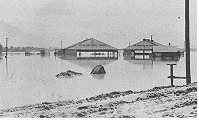
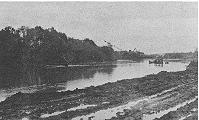
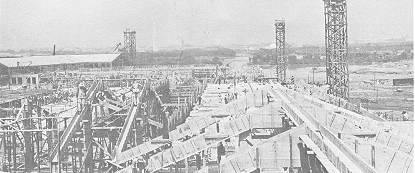
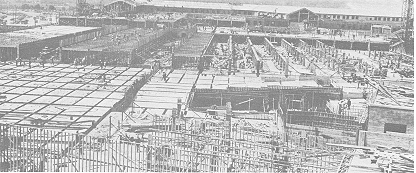
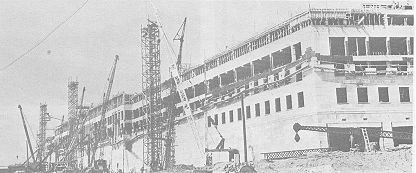
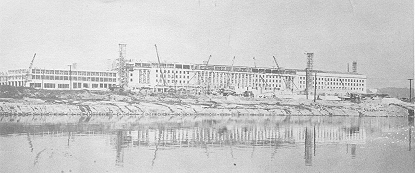
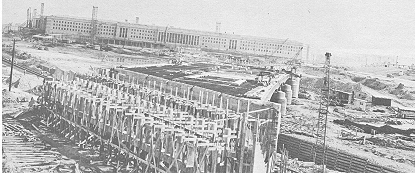
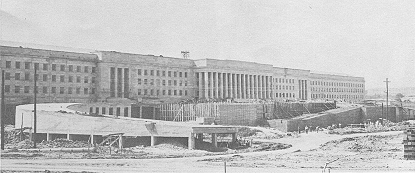
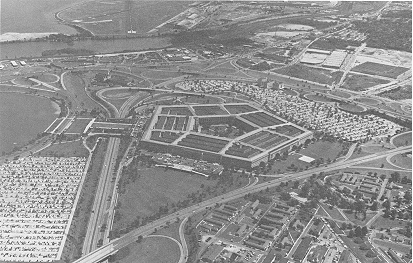
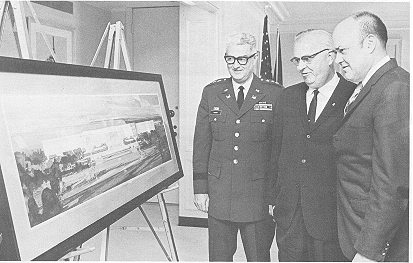
THE HISTORY AND HERITAGE OF
CIVIL ENGINEERING IN
VIRGINIA
The Pentagon Building (1941-1943)
"The Pentagon, headquarters of the Department of Defense, is the world’s largest office building. It is twice as large as the Merchandise Mart in Chicago and has three times the floor space of the Empire State Building in New York. The National Capitol would fit into any one of its five wedged-shaped section" according to the publication "THE PENTAGON", issued by the Department of Defense, April 1960, and since that date has had numerous additions, and expansions of services made.
By the summer of 1941 and during the time of preparation for national defense some 24,000 War Department personnel were housed in 17 buildings scattered through Washington and into nearby Virginia. In May a proposal had been under study for the erection of temporary structures on the outskirts of the City, and a $6,500,000 item had been included in the budget for this purpose and submitted to Congress early in July. Under this plan it appeared that expansion of personnel would increase dispersion, increasing the costs of transportation and communication both in time and money. The official concept of the Pentagon was initiated by Lt. Gen. Brehon B. Somervell, then Commanding Services of Supply, U.S. Army, who had the scheme for housing the entire War Department under one roof, and after discussing this with the Staff carried the idea to Virginia Congressman, Clifton Woodrum, who encouraged him, with the result that an item of $35,000,000 was added to the Supplemental Appropriations Bill for 1942. The greater ease of communication and swiftness of action had strong appeal to the military and it was ready to move towards such a realization, and the economy had Congressional appeal.
In spite of the production of the first basic plans and architectural perspectives in a matter of less than five days after the first indication of Congressional interest, followed by the approval of appropriation and the signature of the President, a delay of another month was experienced in the selection of a site. Various planning and fine arts commissions objected to its location in the Arlington Farms area, fearing comparison of a hurried construction of such an enormous building in the same panoramic view of much of the Washington classical architecture.
The first plan was for a three story structure to reduce the profile and the projection as much as possible in such a comparison. President Franklin D. Roosevelt, himself, after first approving the Arlington Farms location then vacillated in acceptance, although the old Washington-Hoover Airport was here also. General Somervell had the approvals of Under Secretary of War Robert H. Patterson, and Generals Marshall and Moore, and of a Congressional Committee which viewed the site with him. He eventually swayed the Presidential objections and the removal of any Congressional disapproval by proceeding under the original Roosevelt acceptance and initiation of construction procedures under contracts made with John McShain, Inc., of Philadelphia, and Doyle & Russell and Wise Contracting Co., both of Richmond, Virginia. Capt. Clarence Renshaw, a graduate of West Point and career officer in the Corps of Engineers, was detailed as District Engineer in charge, under Gen. Leslie A. Groves, Deputy Chief of Construction.
The original layout on the Arlington Farms site was for a five-sided or pentagon shaped building accessible by five roads; a reinforced concrete structure of 5,100,000 square feet floor space including 300,000 square feet for records storage, a height of first three- then four-stories; and parking for 10,000 vehicles. These plans were modified, particularly after Pearl Harbor, by additional space and facilities, and these plans and specifications of changes were a continual bottleneck throughout construction.
Work was beset from its beginning by squabbles of those with special interests: the President specified that the exterior should not be marble but had no objection to the limestone finally settled upon; the loudest uproar was that in the selection of steel sash over wood; another was a dispute as to the granite when Georgia appeared to be excluded because of color selection; and other less important items. The adherence to reinforced concrete not only satisfied the Office of Production Management but did save an estimated 43,000 tons of steel, probably enough for a battleship. A high accident rate plagued the work, as was natural with the insistence and adherence to the plan for completion within fourteen months.
The overt attack on Pearl Harbor, 7 December, 1941, and national security directed every effort towards provisions for war at the greatest possible speed. As a result many lagging projects were revitalized, after that date, picking up miraculous action under the suspension of bidding regulations. The "Engineering News-Record" epitomized the change in the nation, editorializing, "Building for defense is a thing of the past. The construction industry's new standard must be emblazoned 'Building for Battle'. There is a difference. Time was short. Now there is no more time."
The site of the Pentagon installations was in most part a wasteland, swamp, and dumps, into which, after clearing and grading, was poured 5,500,000 cubic yards of earth fill and grading, and into which was driven 41,492 concrete piles. The dredging of the nearby Potomac River yielded 680,000 tons of sand and gravel and mixed with cement made 435,000 cubic yards of concrete poured into forms to support the structure. General Groves wanted to use brick for the interior walls as it would result in faster construction, but the principal architect, G. Edwin Bergstrom, insisted on architectural concrete, which eventually cost $650,000 more but it is generally agreed that the appearance is more pleasing with the architectural coherence in the structure. The estimated savings in rental with this single building was around $3,000,000 per year, which had considerable appeal to Congress. Another of the prime objectives, rapid communications with coordinated action, was a design so effective that although there are some seventeen and a half miles of corridors, any one point may be reached from another within the building by a walk of not more than six minutes.
The Pentagon building is a gigantic and lasting monument to the American spirit; unity in defense and war; the ingenuity of its architects and engineers; and the force and leadership of its builders. Although its population varies with the military effort and commitments of this nation, the Department of Defense continues to provide the facilities to enhance the capabilities of those housed in its confines, with additional spatial, transportation and communication means as the needs are realized or envisioned.
Most recent released statistical data available on the Pentagon building include the following, as measures of the principal features of this, the largest office building in the world as it was conceived and built:
A. The Site:
-Land, Government owned (acres).........................................................296
-Purchased or condemned (acres)............................................................287
-Total area (acres)...................................................................................583
-Cost..........................................................................................$ 2,245,000
-Area covered by the building (acres).......................................................29
-Heating and ventilating plant area (acres)...................................................1
-Sewerage structures, 3,200,000 gallons per day (acres)............................1
-Access highways built (miles).................................................................30
-Overpasses and bridges built..................................................................21
-Parking space for 10,000 vehicles (acres)...............................................64
B. The Building:
-Gross floor area (square feet)....................................................6,540,360
-Net floor space for offices..........................................................2,613,705
-Concessions and storage............................................................1,091,692
-Volume, cubical contents (cubic feet)........................................77,025,000
-Central court area (acres).........................................................................6
-Length of each outer face (lineal feet)....................................................921
-Height of building, 5 floors, mezzanine and basement.....................71'-31/2"
-Total length of corridors (miles).........................................................171/2
-Number of stairways............................................................................150
-Number of escalators............................................................................19
-Number of elevators..............................................................................13
-Rest rooms..........................................................................................280
-Drinking fountains ...............................................................................685
-Clocks installed................................................................................4,200
-Light fixtures, replacement 1,000 lamps per day..............................85,000
-Windows, area 309,276 square feet (7.1 acres)................................7,748
C. Total cost of project as of April 1960....................................$83,000,000
D. Personnel
-Occupants of offices (as of April 1960)...........................................29,000
-Food service personnel (as of April 1960)............................................625
-Cleaning, guarding, maintenance? etc. (April 1960)............................. 922
E. Construction chronology
-Budget item, first hearing................................................................7/22/41
-President signed supplemental appropriation act............................. 8/25/41
-Prime contract awarded..................................................................8/11/41
-Construction begun.........................................................................8/11/41
-Mechanical contract awarded.........................................................9/03/41
-Grading contract awarded..............................................................9/24/41
-First occupants moved in................................................................4/29/42
-Construction completed (original work)..........................................1/15/43
Sources of Information:
Public Affairs Office, Office Chief of Engineers, U.S. Army
The Pentagon Building, Mrs. Annie Seeley
General Services Administration, Public Buildings Service
The Corps of Engineers: Construction in the United States by Dr. Jessie Remington and Dr. Lenore Fine, historians of the Corps.



|



|



|

|
Click Photo for larger image.
[Top of Page]
[Table of Contents]
Return to Virginia Section Home Page
This page was last revised September 25, 1998. Please send your comments to the Virginia Section Newsletter Editor / Webmaster.